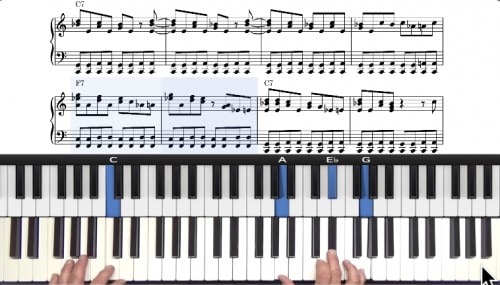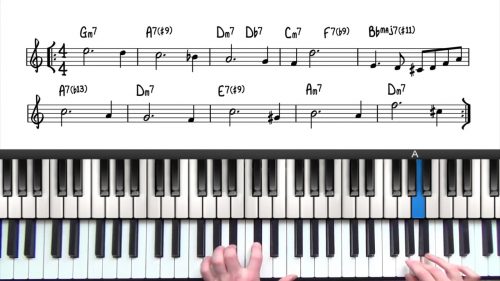Comping On The Hammond Organ
Welcome to our lesson on comping the F Blues on the Hammond organ. In the previous lessons we explored walking bass lines and in this lesson we will apply right hand comping voicings to accompany our own solos or the solo of someone else in the band.
Hammond Drawbar Settings For Comping
Most Hammond organ comping uses the lower manual with the same drawbar setting that we used for our left hand bass lines.
We’re lucky that the same setting is great for comping and for bass lines as we can walk bass and comp on the same drawbar preset.
To review, this is the first and third drawbars pulled out all the way, and the one between them set somewhere in the range of zero to five. You’ll need to explore what you like for that setting of the second drawbar; each organ is a little different.
Comping On The Lower Manual
Most of the comping will take place in the upper registers of the lower manual. There are times when our comping voicings will cross over our bass line contours and this is an important part of Hammond organ technique.
Fewer Notes Than Piano Voicings
It’s rare in Hammond organ to play big 2-handed voicings. Whilst it sounds good, it does not leave us any fingers to walk our bass line. Most hammond organ comping is with voicings containing fewer notes, although the notes can spread over an octave. Robert shows some common voicings for playing jazz organ.
Comping During Your Solo
Often when playing jazz organ, you will be comping for your own solo and adding comping chords on the lower manual when your solo takes a break.
We can use this as an opportunity to outline the harmony and cadences whilst our solo breathes. We can also play ‘pitch-less pops’ using the palm of our hand. Robert demonstrates these two techniques.
Lesson Downloads
-
Comping Lesson Notation File Type: pdf
Practice Tips
-
Two-handed chord voicings are pretty unusual in jazz organ, much less common than in jazz piano
-
Watch out for overly-muddy or overly-colourful piano-style voicings like stacked diminished chords.
-
Vary comping with long notes, short held notes, short stabs, pitch-less pops, and don't forget to use grace notes and chromatic slides.
-
Just as on piano, rhythm is vital and leaving space is a huge part of effective and appropriate comping technique.







